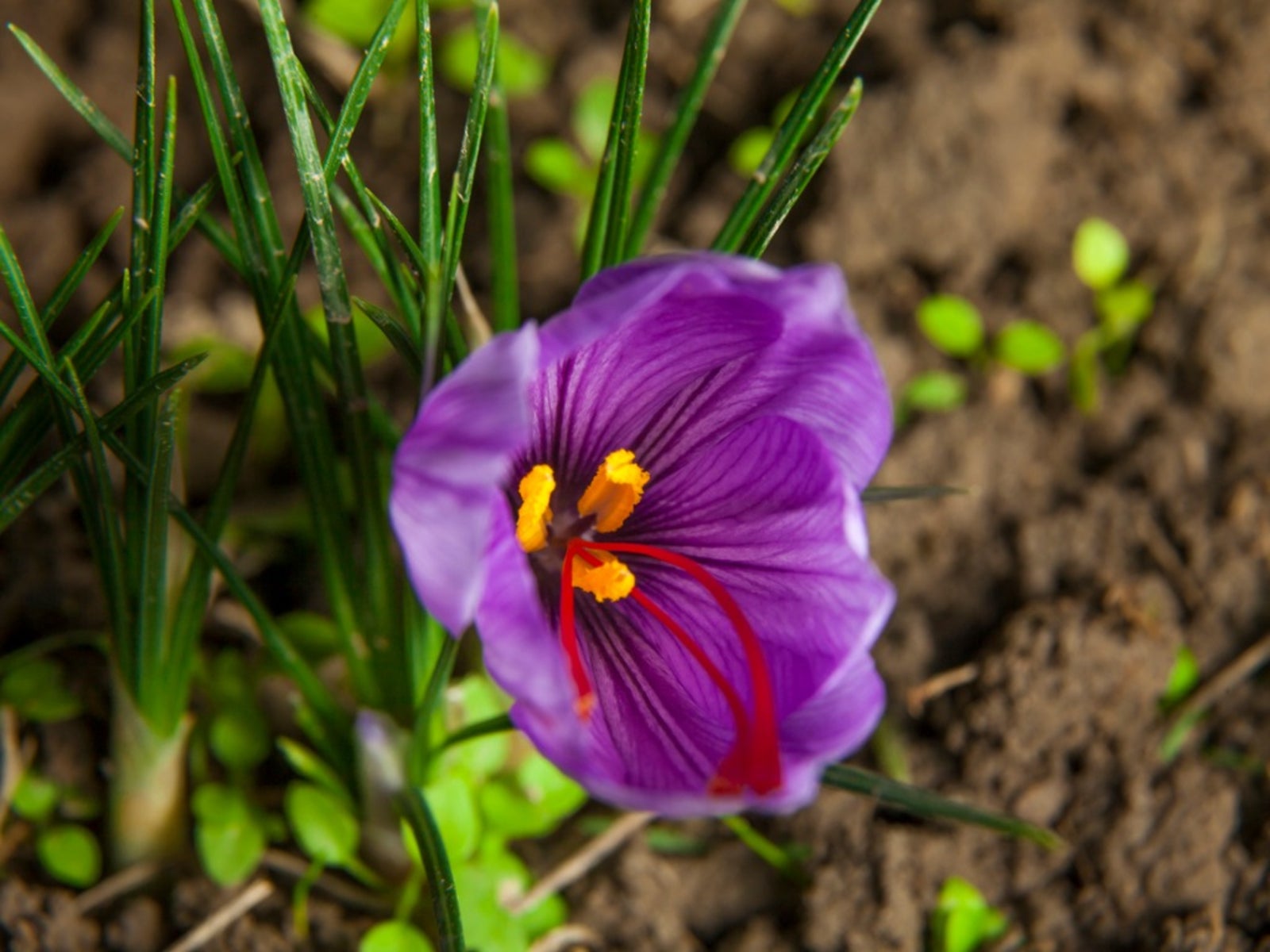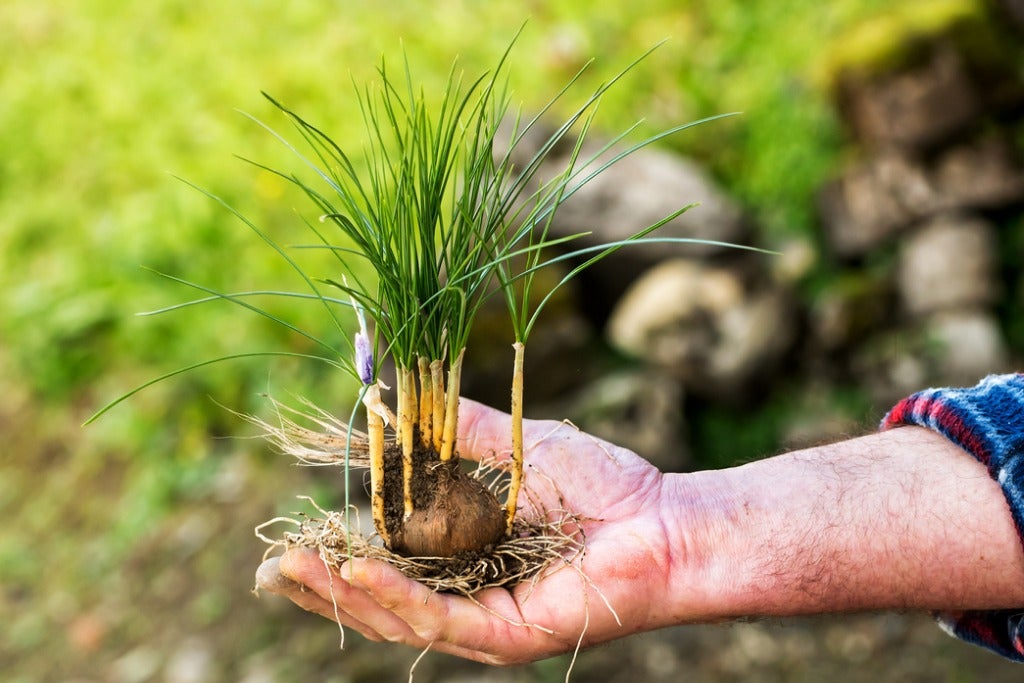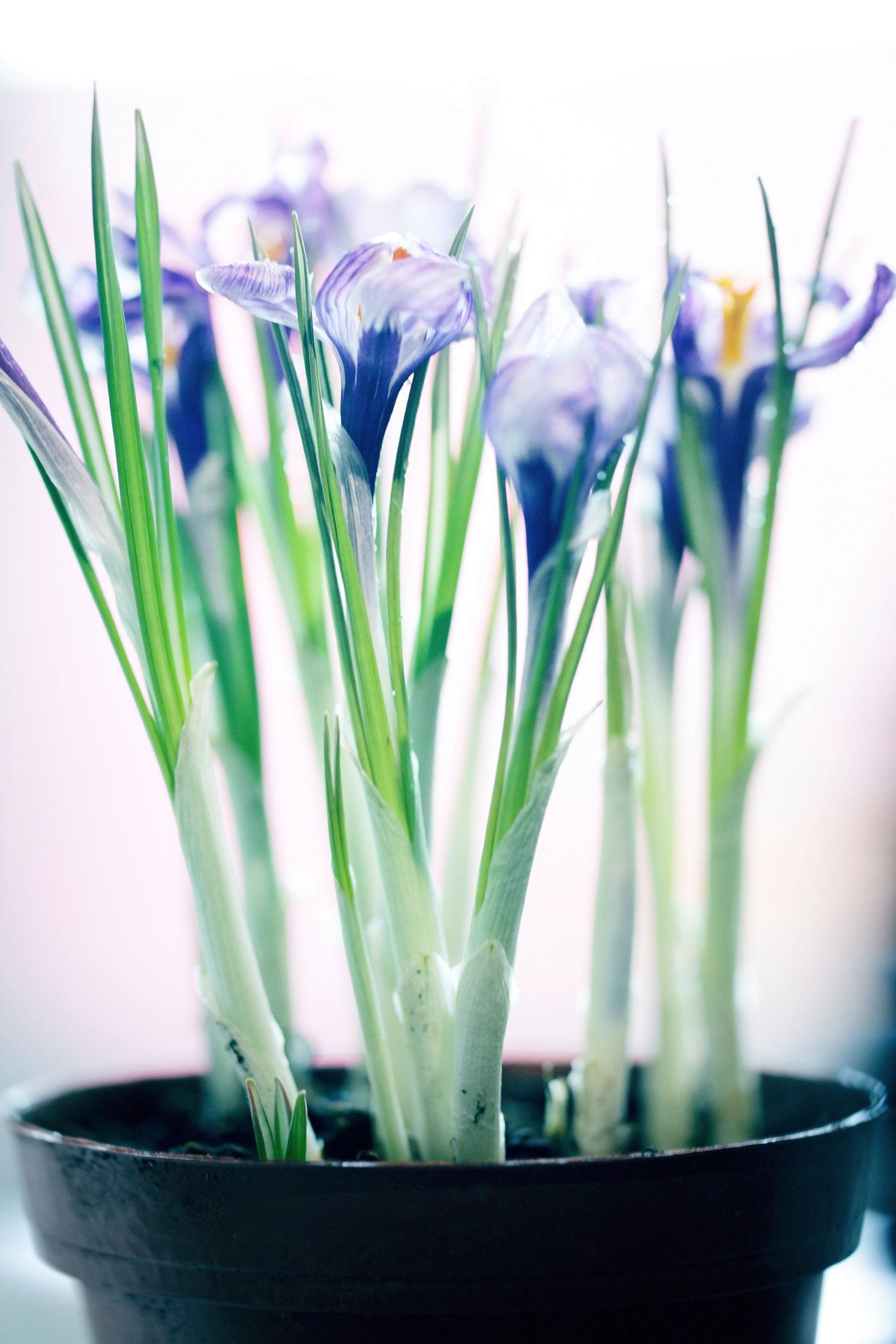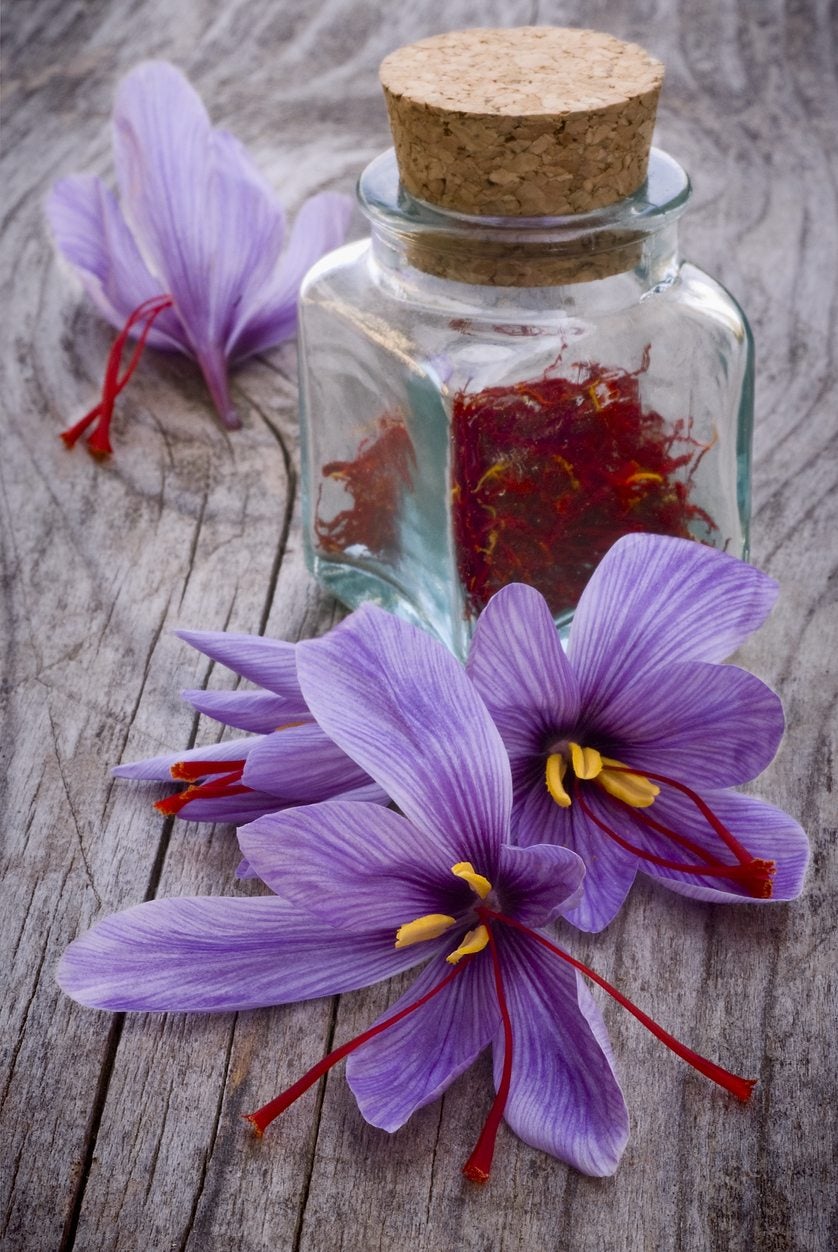Saffron Flowers: Complete Plant Care & Growing Guide
Learn how to grow saffron crocus is worth the time and effort to have this incredibly expensive and delicious spice at your fingertips.

Saffron Flowers: How To Grow The Expensive Spice At Home
Saffron is one of the oldest spices, known to be used since the 7th century. It was widely sought after and traded for centuries and is still an important part of many international cuisines. The saffron plant is actually a crocus, a bulbed flowering specimen that may be grown in United States Department of Agriculture zones 5-8.
A cousin of the iris, saffron crocus is a perennial plant from which the 3 female stigmas are harvested as a seasoning. It’s a tedious process, but one which the home gardener can embark upon once they know how to grow saffron.
Quick Facts
- Botanical name: Crocus sativus
- Height: 12-18 inches (31-46 cm)
- Spread: 12 inches (31 cm)
- Sun exposure: Full to partial
- Soil requirements: Well draining, moderately fertile
- Hardiness zones: USDA 5-8
- When to plant: Spring
Saffron Crocus Care
The saffron flower is the source of this expensive spice. In modern times, Iran produces around 90 percent of the spice. It is still a valuable crop, commanding high prices due to the labor intensive harvest. Gardeners may plant saffron crocus bulbs and expect a modest harvest in that year. The pollen from the plant is also an excellent and permanent textile dye. It is propagated from the corms that form around the mother bulb.
Light
Saffron plants require at least 6 hours of bright light daily. A full sun to partial shade location is acceptable, provided the lower light area gets full sun during the brightest part of the day.
Water
One of the biggest issues with saffron corms is when they are planted where water stands. In areas where moisture collects, the corms will rot and die. These plants are commercially grown in areas with little rainfall and porous soils. Water the area only when the soil is fully dry. Do not water the plants when they are not actively growing. The bulb cannot uptake excess water when it is dormant and the corm could rot.
Gardening tips, videos, info and more delivered right to your inbox!
Sign up for the Gardening Know How newsletter today and receive a free copy of our e-book "How to Grow Delicious Tomatoes".
Temperature & Humidity
Native to southern Europe and Asia, these are not terribly frost hardy. In areas with deep freezes, the corm may become damaged. As a warm weather plant, rising temperatures trigger the bulb to begin growth. However, excessive heat will stunt the plant and prevent the production of flowers. The ideal temperature for flower production is 70 degrees Fahrenheit (21 C) but they will survive in temperatures between 50-100 F. (10-38 C). Greenhouse saffron is kept in humidity of 45-55, but this can be difficult to achieve in the garden bed. Gardeners in areas of high humidity, such as Florida, may struggle to keep the plant blooming.
Soil
Because standing water can rot the corm, loose, well draining soil is essential. Incorporate several inches (7 cm) to the soil if the area tends to hold too much water or is mostly clay. Sandy loam is an ideal substrate for growing the crocus.
Fertilizer
The corms should have some bulb food or bone meal incorporated into the hole at planting. Feed the plants annually after flowering with a good bulb fertilizer and once in early spring. Or, use a time release food at the beginning of the season that will slowly provide needed nutrients during the growing period. Suspend feeding once the leaves turn yellow.
Problems, Pests & Diseases
Overwatering and poorly draining soil produce the biggest issues. Fungal issues and root or bulb rot may occur. The other largest problem is from furry pests like chipmunks and squirrels, which will dig up the bulbs.
How to Plant Saffron
Prepared soil needs to be loosened deeply, to at least twice the size of the corm. Plant the corms 2 inches (5 cm) deep and 4 inches (10 cm) apart. Plant with the flat side down. This is where the growth and root development will start. Pack the soil firmly over the site and water moderately unless rain is expected.
Pruning
Saffron crocus doesn't require pruning. They will however, need to be divided every few years. Over time, the corms will enlarge and produce little cormlets. The number of flowers will increase, but the site will become crowded, producing poor growth. Dig up the area, and replant the healthy corms separately.
Propagation
Saffron grows vegetatively from its corms. These are formed alongside a mature corm and will produce green sprouts the first year only. In the next year, the new plants will flower. They can be moved to new sites to develop into a crop.
Harvesting Saffron Stigmas
The saffron flowers’ three stigmas may be removed gently with tweezers while the flower is still intact on the plants. Harvesting takes patience and time and can only be done during a few weeks in late October to early November when the flowers ae in full bloom. They are delicate and should be plucked and handled carefully.
Repotting
Corms grown in containers should be planted in slightly sandy soil for best drainage. After a few years, remove all the corms, separate them, and discard any that have signs of damage. Change the soil and replant the healthy corms.
Saffron Crocus Varieties
The only crocus used for its edible stigmas is Crocus sativus. It is also called Autumn or Fall crocus. There is a cultivar called “Cashmirianus” that is a better choice for northern gardeners and a prolific bloomer.
Frequently Asked Questions
How Can You Use Saffron Flowers?
Saffron stigmas are soaked prior to use. They are also used in a powdered form and can be directly added to a dish. Saffron is classically used in recipes like paella, bouillabaisse, and risottos. They add a lovely color and delicate flavor to soups, sauces, and other recipes.
Why Is Saffron So Expensive?
Saffron stigmas are very small, just barely larger in diameter than a thick hair. They must be harvested with tweezers and then dried. After drying, they lose 80 percent of their weight. Since there are only 3 stigmas in each flower, it takes a large plot of the plants just to produce enough for moderate use. It takes roughly 150 flowers to produce 1 gram of the spice. The harvest process is labor-intensive and yields small quantities.

Heather Rhoades founded Gardening Know How in 2007. She holds degrees from Cleveland State University and Northern Kentucky University. She is an avid gardener with a passion for community, and is a recipient of the Master Gardeners of Ohio Lifetime Achievement Award.
-
 Get Ready For A Summer Of Hummers! Grow These Full Sun Hummingbird Plants and Flowers
Get Ready For A Summer Of Hummers! Grow These Full Sun Hummingbird Plants and FlowersIf you’re lucky enough to enjoy a sunny backyard, make sure you are maxing out on your pollinator opportunities and grow these full sun hummingbird plants and flowers
By Tonya Barnett
-
 12 Lush Alternatives To A Lawn For Sustainable Spaces
12 Lush Alternatives To A Lawn For Sustainable SpacesAlternatives to a lawn are beautiful and also beneficial to your local ecosystem and its pollinators. Explore our top picks for plants to replace grass.
By Tonya Barnett
-
 Non Blooming Saffron Crocus - How To Get Saffron Crocus Flowers
Non Blooming Saffron Crocus - How To Get Saffron Crocus FlowersIn order to enjoy the beauty of the flowers and, more importantly, protect your pocketbook, finding out why saffron crocus is not blooming is crucial. Read this article to find out how to get saffron crocus flowers in full production.
By Bonnie L. Grant
-
 Growing Saffron Indoors: Care Of Saffron Crocus In The Home
Growing Saffron Indoors: Care Of Saffron Crocus In The HomeThe care of saffron crocus is no more difficult than that of any other type of bulb. In fact, it can even be grown indoors. Container-grown saffron is easy. Read this article to learn about their indoor care.
By Amy Grant
-
 Saffron Harvest Info: How And When To Pick Saffron
Saffron Harvest Info: How And When To Pick SaffronThere's more to saffron than just growing it. You need to know how and when to harvest the herb. Learn about saffron crocus harvesting and its uses today by reading this article.
By Amy Grant
-
 Container Grown Saffron - Care Of Saffron Crocus Bulb In Containers
Container Grown Saffron - Care Of Saffron Crocus Bulb In ContainersSaffron is an ancient spice that has been used as a flavor for food and also as a dye. Saffron comes from the three stigmas of the fall blooming Crocus sativus plant. Learn how to grow these plants in pots in this article.
By Susan Patterson
